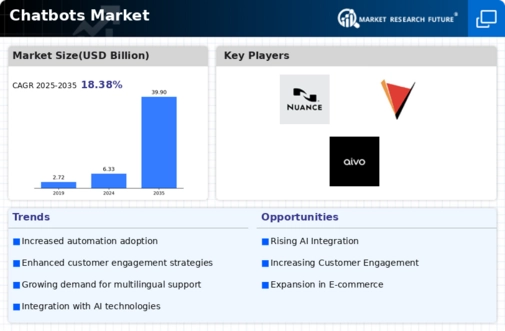Market Trends
Introduction
As we enter 2025, the chatbot market is undergoing a significant transformation. Artificial intelligence and natural language processing have become the mainstays of the chatbot market. These have enabled a more human-like interaction with users, thereby improving the user experience. Similarly, regulatory pressures around data privacy and security are driving the adoption of chatbots that are compliant with industry standards and hence can ensure customer trust. Meanwhile, the increasing trend of instant and personalised customer service is a key factor driving the adoption of chatbots. These trends are strategically important for stakeholders, who must keep up with a rapidly changing environment.
Top Trends
-
Increased Adoption of AI-Powered Chatbots
In a word, a chatbot is the norm in many industries, and by 2025 it will be the rule. Companies like IBM have already integrated AI into their customer service solutions to improve the customer experience. This trend is improving productivity and reducing response times by as much as 50%. In the future, the natural language processing will be further developed and the customer interaction will be further improved. -
Integration with Voice Assistants
In the United States, the integration of voice and chatbots is growing, with forty percent of consumers preferring to communicate by voice. Industry leaders are using this trend to increase their reach and engagement with their customers. Nuance, for example, has developed a chatbot that uses voice to improve the quality of care for patients. This trend will continue, leading to a more seamless experience between different channels of communication. -
Focus on Personalization
Personalization of chatbot interactions is becoming a necessity. According to the report, 80% of consumers are more engaged with a brand that offers a personalized experience. Aivo is one of the companies that uses data analytics to personalize responses to individual users’ behavior. This will lead to greater customer satisfaction and loyalty, and thus more repeat purchases. Future developments could be even more advanced in their use of big data to increase the level of personalization. -
Enhanced Security Features
The security of the data managed by the chatbots is becoming a priority. Inbenta Technologies has therefore developed a secure encryption protocol for its chatbots. This trend is essential for the confidence of the public and for compliance with the regulations. In the future, the development of artificial intelligence may lead to the use of security tools to prevent and detect attacks in real time. -
Expansion into Multilingual Support
Multilingual chatbots are on the rise, with fifty per cent of users preferring to communicate in their own language. Creative Virtual has developed a multilingual chatbot that can handle any language. This is vital for any business wanting to increase its customer base and customer satisfaction. Future developments will include instant translations, further breaking down language barriers. -
Integration with CRM Systems
In the United States, 65% of companies are using chatbots in combination with their customer relationship management systems. Companies such as eGain offer solutions that allow you to connect chatbots to your existing CRM system. This trend increases the data that companies can use to understand their customers and make better business decisions. Future developments could see the automation of data entry and analysis. -
Rise of Conversational Commerce
With the increase in the use of chatbots, about thirty per cent of consumers use them to shop. Companies like Acuvate are now using chatbots to make transactions possible directly in a messenger. This trend is changing the retail landscape and boosting sales through better customer engagement. In the future, we can expect more sophisticated payment integrations and a more personal shopping experience. -
Increased Use in Healthcare
It is an increasingly frequent phenomenon for chatbots to be used in the health care sector, and some 45% of health care institutions are using them for patient communication. Among other things, the Next IT Corp has developed a chatbot for appointment-making and symptom-checking. This development has the advantage of improving access to care and reducing administrative costs. In the future, symptom-checking and diagnosis may be carried out with the help of artificial intelligence, and the possibilities for improving health care may be even greater. -
Emphasis on Emotional Intelligence
In the last few years, the importance of emotional intelligence in chatbots has increased considerably. Moreover, 55% of users prefer emotional recognition of their emotional state. Artificial Solutions is the pioneer in developing chatbots that can recognize the emotional state of a person and respond to it accordingly. This is a crucial trend for increasing customer satisfaction and loyalty. This may lead to more empathetic chatbots, which in turn may improve the customer experience. -
Utilization of Analytics for Continuous Improvement
A study by the Boston Consulting Group has shown that a majority of companies are already using data to improve their chatbots’ performance. Creative Virtual is one of those that use data to track customer behavior and optimize responses. This trend is resulting in a steady improvement in the chatbots’ performance and a better experience for users. Future developments could include real-time data analysis that allows the chatbots to be adjusted on the fly.
Conclusion: Navigating the Chatbots Market Landscape
Competition is fierce in the chatbot market as we approach 2025, with both established companies and new start-ups competing for market share. In terms of geography, the trend is towards greater uptake in North America and Asia-Pacific, driven by technological advances in automation and artificial intelligence. To compete, vendors must focus on deploying new capabilities in personalization, automation and sustainable practices. These are the main areas of innovation for the incumbents. In the long term, the ability to integrate advanced AI, ensure operational agility and commit to sustainable practices will determine the leaders in this fast-evolving market.

















Leave a Comment